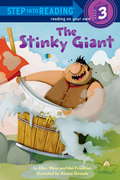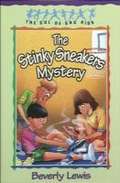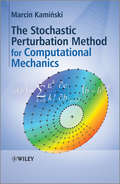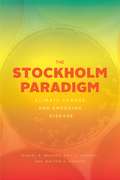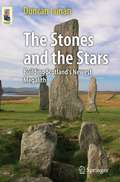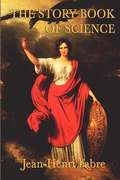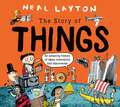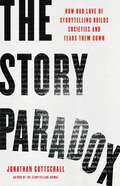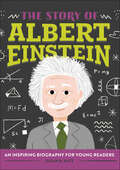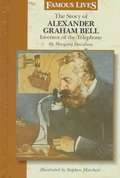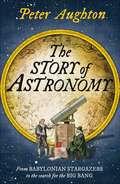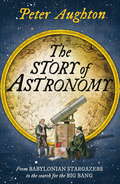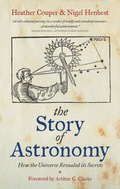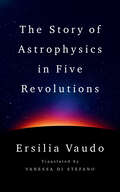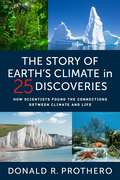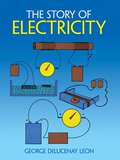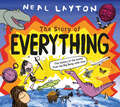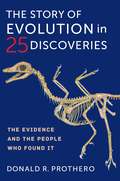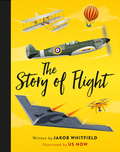- Table View
- List View
The Stinky Giant (Step into Reading)
by Ellen Weiss Mel FriedmanPepper and Jake love herding sheep in the little valley where they live. But there's a problem-- a big problem. Urk, a giant who lives on a nearby mountain, is big and stinky and doesn't care that dumping dirty laundry water in the nearby stream causes a flood down below every single week. So Pepper and Jake hike to Urk's mountaintop lair to confront him. But there's no reasoning with a giant, especially one who gives cryptic puzzles to solve. If the kids can solve it, Urk will move away. If not, Pepper and Jake (and their sheep) will be the featured ingredients in Urk's next bowl of smelly soup!
The Stinky Sneakers Mystery (The Cul-De-Sac Kids #7)
by Beverly LewisJason Birchall's been bragging all week about his science fair project--alfalfa sprouts growing in a carpet square! But on the morning of the fair, Jason's super sprouts are missing. What can he do? And why does Eric Hagel look so sneaky? Will Jason's super-smelly plan to get back at Eric cause a stink in the cul-de-sac?
The Stochastic Perturbation Method for Computational Mechanics
by Marcin KaminskiProbabilistic analysis is increasing in popularity and importance within engineering and the applied sciences. However, the stochastic perturbation technique is a fairly recent development and therefore remains as yet unknown to many students, researchers and engineers. Fields in which the methodology can be applied are widespread, including various branches of engineering, heat transfer and statistical mechanics, reliability assessment and also financial investments or economical prognosis in analytical and computational contexts.Stochastic Perturbation Method in Applied Sciences and Engineering is devoted to the theoretical aspects and computational implementation of the generalized stochastic perturbation technique. It is based on any order Taylor expansions of random variables and enables for determination of up to fourth order probabilistic moments and characteristics of the physical system response.Key features:Provides a grounding in the basic elements of statistics and probability and reliability engineeringDescribes the Stochastic Finite, Boundary Element and Finite Difference Methods, formulated according to the perturbation method Demonstrates dual computational implementation of the perturbation method with the use of Direct Differentiation Method and the Response Function Method Accompanied by a website (www.wiley.com/go/kaminski) with supporting stochastic numerical softwareCovers the computational implementation of the homogenization method for periodic composites with random and stochastic material propertiesFeatures case studies, numerical examples and practical applicationsStochastic Perturbation Method in Applied Sciences and Engineering is a comprehensive reference for researchers and engineers, and is an ideal introduction to the subject for postgraduate and graduate students.
The Stockholm Paradigm: Climate Change and Emerging Disease
by Daniel R. Brooks Eric P. Hoberg Walter A. BoegerThe contemporary crisis of emerging disease has been a century and a half in the making. Human, veterinary, and crop health practitioners convinced themselves that disease could be controlled by medicating the sick, vaccinating those at risk, and eradicating the parts of the biosphere responsible for disease transmission. Evolutionary biologists assured themselves that coevolution between pathogens and hosts provided a firewall against disease emergence in new hosts. Most climate scientists made no connection between climate changes and disease. None of these traditional perspectives anticipated the onslaught of emerging infectious diseases confronting humanity today. As this book reveals, a new understanding of the evolution of pathogen-host systems, called the Stockholm Paradigm, explains what is happening. The planet is a minefield of pathogens with preexisting capacities to infect susceptible but unexposed hosts, needing only the opportunity for contact. Climate change has always been the major catalyst for such new opportunities, because it disrupts local ecosystem structure and allows pathogens and hosts to move. Once pathogens expand to new hosts, novel variants may emerge, each with new infection capacities. Mathematical models and real-world examples uniformly support these ideas. Emerging disease is thus one of the greatest climate change–related threats confronting humanity. Even without deadly global catastrophes on the scale of the 1918 Spanish Influenza pandemic, emerging diseases cost humanity more than a trillion dollars per year in treatment and lost productivity. But while time is short, the danger is great, and we are largely unprepared, the Stockholm Paradigm offers hope for managing the crisis. By using the DAMA (document, assess, monitor, act) protocol, we can “anticipate to mitigate” emerging disease, buying time and saving money while we search for more effective ways to cope with this challenge.
The Stones and the Stars
by Duncan LunanThere are at least 48 identified prehistoric stone circles in Scotland. In truth, very little is known about the people who erected them, and ultimately about what the stone circles were for. Most stone circles are astronomically aligned, which has led to the modern debate about why the alignment was significant. The megaliths certainly represented an enormous co-operative effort, would at the very least have demonstrated power and wealth, and being set away from any dwellings probably served a ceremonial, or perhaps religious, purpose. Observations at the site of the stone circles, of solar, lunar, and stellar events, have already cast light on some of the questions about the construction and use of ancient megalithic observatories. In his capacity as manager of the Parks Department Astronomy Project, author Duncan Lunan designed and built the first astronomically aligned stone circle in Britain in over 3,000 years. 'The Stones and the Stars' examines the case for astronomical alignments of stone circles, and charts the development of a fascinating project with a strong scientific and historical background. The work was documented in detail by the artist and photographer Gavin Roberts, and this archive has been added to since - so an appropriate selection of illustrations will bring the project vividly to life.
The Story Book of Science
by Jean Henri FabreFabre had many scholarly achievements. He was a popular teacher, physicist, chemist, and botanist. However, he is probably best known for his findings in the field of entomology, the study of insects, and is considered by many to be the father of modern entomology. Much of his enduring popularity is due to his marvelous teaching ability and his manner of writing about the lives of insects in biographical form.
The Story Of Things
by Neal LaytonTake a fascinating journey through time to explore a world full of ideas, inventions, discoveries and many, many ... things! Have you ever wondered how us humans came to have so many 'things'?Starting with the early humans who had very few things, through to the jam-packed world we live in today, discover how from the very beginning we humans have had the urge to invent and create! From the creation of Stone Age tools and the first handwritten book through to amazing inventions including the steam engine and the laptop computer, find out how things have transformed our world.With fun illustrations and witty text by award-winning author and illustrator Neal Layton.
The Story Paradox: How Our Love of Storytelling Builds Societies and Tears them Down
by Jonathan GottschallStorytelling, a tradition that built human civilization, may soon destroy itHumans are storytelling animals. Stories are what make our societies possible. Countless books celebrate their virtues. But Jonathan Gottschall, an expert on the science of stories, argues that there is a dark side to storytelling we can no longer ignore. Storytelling, the very tradition that built human civilization, may be the thing that destroys it.In The Story Paradox, Gottschall explores how a broad consortium of psychologists, communications specialists, neuroscientists, and literary quants are using the scientific method to study how stories affect our brains. The results challenge the idea that storytelling is an obvious force for good in human life. Yes, storytelling can bind groups together, but it is also the main force dragging people apart. And it&’s the best method we&’ve ever devised for manipulating each other by circumventing rational thought. Behind all civilization&’s greatest ills—environmental destruction, runaway demagogues, warfare—you will always find the same master factor: a mind-disordering story.Gottschall argues that societies succeed or fail depending on how they manage these tensions. And it has only become harder, as new technologies that amplify the effects of disinformation campaigns, conspiracy theories, and fake news make separating fact from fiction nearly impossible.With clarity and conviction, Gottschall reveals why our biggest asset has become our greatest threat, and what, if anything, can be done. It is a call to stop asking, &“How we can change the world through stories?&” and start asking, &“How can we save the world from stories?&”
The Story Within: Personal Essays on Genetics and Identity
by Amy BoeskyA thought-provoking collection of personal essays explores complex issues surrounding genetic identity.The contributors to The Story Within share powerful experiences of living with genetic disorders. Their stories illustrate the complexities involved in making decisions about genetic diseases: whether to be tested, who to tell, whether to have children, and whether and how to treat children medically, if treatment is available. More broadly, they consider how genetic information shapes the ways we see ourselves, the world, and our actions within it. People affected by genetic disease respond to such choices in varied and personal ways. These writers reflect that breadth of response, yet they share the desire to challenge a restricted sense of what "health" is or whose life has value. They write hoping to expand conversations about genetics and identity—to deepen debate and generate questions. They or their families are affected by Huntington’s disease, Alzheimer’s disease, cancer, genetic deafness or blindness, schizophrenia, cystic fibrosis, Tay-Sachs, hypertrophic cardiomyopathy, fragile X, or Fanconi anemia. All of their stories remind us that genetic health is complicated, dynamic, and above all, deeply personal.ContributorsMisha Angrist, Amy Boesky, Kelly Cupo, Michael Downing, Clare Dunsford, Mara Faulkner, Christine Kehl O’Hagan, Charlie Pierce, Kate Preskenis, Emily Rapp, Jennifer Rosner, Joanna Rudnick, Anabel Stenzel (deceased), Isabel Stenzel Byrnes, Laurie Strongin, Patrick Tracey, Alice Wexler
The Story of Albert Einstein: An Inspiring Biography for Young Readers (The Story Of)
by Susan B. KatzDiscover the life of Albert Einstein—a story about asking questions and discovering big things for ages 6 to 9Albert Einstein became one of the most important scientists in history for his discoveries about physics and how our universe works. Before everyone knew him as a genius, Albert was a curious kid who loved reading, learning, and experimenting with new ideas. He asked big questions and wasn't afraid to make mistakes. Explore how Albert Einstein went from being a young Jewish boy growing up in Germany to the most celebrated physicist ever.Independent reading—This Albert Einstein biography is broken down into short chapters and simple language so kids 6 to 9 can read and learn on their own.Critical thinking—Kids will learn the Who, What, Where, When, Why, and How of Albert's life, find definitions of new words, discussion questions, and more.A lasting legacy—See Albert progress from curious kid to famous scientist with a visual timeline!How will Albert Einstein's life encourage your own curiosity about the world?Discover activists, artists, and athletes, and more from all across history with the rest of The Story Of series, including famous figures like: Marie Curie, Ruth Bader Ginsburg, Leonardo Da Vinci, Anne Frank, and Benjamin Franklin.
The Story of Alexander Graham Bell, Inventor of the Telephone
by Margaret DavidsonA readable, interesting biography of the famous inventor, paying equal attention to his scientific achievements, his personal life, and his lifelong work with the deaf. There are several odd omissions, though, including why Bell adopted the middle name Graham; the spilled-acid aspect of the first telephone message and Bell's demonstration of the telephone before Queen Victoria.
The Story of Apollo 11 (Cornerstones of Freedom)
by R. Conrad SteinHighlights man's efforts to journey to the moon, with a detailed account of the first landing achieved by Apollo 11.
The Story of Astronomy
by Peter AughtonFrom the ancient origins of astronomy to the Copernican revolution, and from Galileo to Hawking's research into black holes, The Story of Astronomy charts the discoveries of some of the greatest minds in human history, and their attempts to unveil the secrets of the stars. Peter Aughton's trademark narrative style is to the fore, demystifying some of the biggest breakthroughs in the history of science, and packed full of fascinating nuggets such as why we have 60 minutes in an hour, how the Romans bodged the invention of the leap year and when people really discovered the Earth wasn't flat (a thousand years before Columbus). And explaining in the most straightforward and compelling of ways what Newton, Einstein, Hubble and Hawking really achieved.
The Story of Astronomy
by Peter AughtonFrom the ancient origins of astronomy to the Copernican revolution, and from Galileo to Hawking's research into black holes, The Story of Astronomy charts the discoveries made by some of the greatest minds in human history, and their attempts to unveil the secrets of the stars. Written in an accessible and entertaining style, The Story of Astronomy demystifies some of the biggest breakthroughs in the history of science, as well as explaining why we have 60 minutes in an hour, how the Romans bodged the invention of the leap year and when people really discovered the Earth wasn't flat (a thousand years before Columbus. In the most straightforward and compelling of ways Peter Aughton demonstrates the beauty and wonder of what Newton, Einstein, Hubble and Hawking really achieved.
The Story of Astronomy
by Peter AughtonFrom the ancient origins of astronomy to the Copernican revolution, and from Galileo to Hawking's research into black holes, The Story of Astronomy charts the discoveries made by some of the greatest minds in human history, and their attempts to unveil the secrets of the stars. Written in an accessible and entertaining style, The Story of Astronomy demystifies some of the biggest breakthroughs in the history of science, as well as explaining why we have 60 minutes in an hour, how the Romans bodged the invention of the leap year and when people really discovered the Earth wasn't flat (a thousand years before Columbus. In the most straightforward and compelling of ways Peter Aughton demonstrates the beauty and wonder of what Newton, Einstein, Hubble and Hawking really achieved.
The Story of Astronomy: How the Universe Revealed its Secrets
by Nigel Henbest Heather CouperJourney through time and space with the greatest astronomers in history. Astronomy is one of the oldest of all the sciences. And yet, its history is also so much more than the history of a science, reflecting our entire culture and providing insight into the evolution of humankind's ideas and ideals over the centuries. This fascinating book tells the amazing story of the development of astronomy, through the key characters in its history from Copernicus to Hubble and Halley, the excitement of new discoveries and the ways in which the history of the skies has affected our lives and how we look at the planet on which we live.The Story of Astronomy celebrates changing perspectives (from the Ancient Greeks to the latest scientific advances) as different cultures, philosophers and scientists sought to come to terms with their, and earth's, place in the Cosmos.Exhaustively researched and containing interviews with many of the world's leading astronomers, including Stephen Hawking, this is the ultimate history of how the universe has revealed itself to us over the millennia.
The Story of Astronomy: How the universe revealed its secrets
by Nigel Henbest Heather CouperJourney through time and space with the greatest astronomers in history. Astronomy is one of the oldest of all the sciences. And yet, its history is also so much more than the history of a science, reflecting our entire culture and providing insight into the evolution of humankind's ideas and ideals over the centuries. This fascinating book tells the amazing story of the development of astronomy, through the key characters in its history from Copernicus to Hubble and Halley, the excitement of new discoveries and the ways in which the history of the skies has affected our lives and how we look at the planet on which we live.The Story of Astronomy celebrates changing perspectives (from the Ancient Greeks to the latest scientific advances) as different cultures, philosophers and scientists sought to come to terms with their, and earth's, place in the Cosmos.Exhaustively researched and containing interviews with many of the world's leading astronomers, including Stephen Hawking, this is the ultimate history of how the universe has revealed itself to us over the millennia.
The Story of Astrophysics in Five Revolutions
by Ersilia VaudoA concise, elegant overview of how five of the most extraordinary moments of vision and intuition in science history forever transformed our understanding of the cosmos—and what we may yet discover in revolutions still to come. When Neil Armstrong first set foot in the lunar dust, the Earth held its breath. That one small step forever changed our view of what was possible, sparking a dramatic expansion of humankind’s cosmic awareness. When we gain a new perspective, a transformation begins, profoundly altering the understanding of the world our human experience had previously granted us. In The Story of Astrophysics in Five Revolutions, astrophysicist Ersilia Vaudo explores five such turning points in the history of cosmology: Newton’s realization that gravity governs the celestial world; Einstein’s dual theories of relativity, linking space with time and gravity with acceleration; Hubble’s revelation of an expanding, rather than static, universe; and the emergence of antiparticles from a mathematical equation and their implications for our cosmic evolution. In poetic prose, Vaudo illuminates the key insights that have led us to where we stand now. At the same time, she urges us to look beyond—to be open to the transformative realizations yet to come in our ongoing quest to understand the extraordinary, and still largely mysterious, universe to which we belong
The Story of Chemistry
by N. C. DattaThe study of the history of science is essential for understanding the development of scientific thought. It enables one to realize the tribulations and travails of the people who make scientific discoveries possible.
The Story of Earth's Climate in 25 Discoveries: How Scientists Found the Connections Between Climate and Life
by Donald R. ProtheroOver 4.5 billion years, Earth’s climate has transformed tremendously. Before our more temperate recent past, the planet swung from one extreme to another—from a greenhouse world of sweltering temperatures and high sea levels to a “snowball earth” in which glaciers reached the equator. During this history, we now know, living things and the climate have always influenced and even shaped each other. But the climate has never changed as rapidly or as drastically as it has since the Industrial Revolution.In this lively and entertaining book, Donald R. Prothero explores the astonishing connections between climate and life through the ages, telling the remarkable stories of the scientists who made crucial discoveries. Journeying through the intertwined evolution of climate and life, he tackles questions such as: Why do we have phytoplankton to thank for the air we breathe? What kind of climate was necessary for the rise of the dinosaurs—or the mammals, their successors? When and how have climatic changes caused mass extinctions? Prothero concludes with the Ice Ages and the Holocene, the role of climate in human history, and the perils of anthropogenic climate change. Understanding why the climate has changed in the past, this timely book shows, is essential to grasping the gravity of how radically human activity is altering the climate today.
The Story of Electricity: With 20 Easy-to-Perform Experiments
by George De LeonEasy-to-follow instructions for performing 20 famous experiments that led to major discoveries in electricity and magnetism over the past 2,500 years. Safe, clearly illustrated projects involve compasses, batteries, electromagnets, thermocouples, generators, more. List of inexpensive, readily available materials. Grades 4-6.
The Story of Everything
by Neal LaytonDiscover the mind-blowing story of how everything came to be with award-winning illustrator and author Neal Layton.With a unique collage art style, and quirky, engaging text, The Story of Everything explores big ideas in a way that will grip even the most reluctant reader. From the Big Bang theory and the beginnings of life on Earth, through to the evolution of humans, the Ice Age and the building of towns and cities, children will be gripped by the real-life action adventure that is EVERYTHING!
The Story of Evolution in 25 Discoveries: The Evidence and the People Who Found It
by Donald R. ProtheroThe theory of evolution unites the past, present, and future of living things. It puts humanity’s place in the universe into necessary perspective. Despite a history of controversy, the evidence for evolution continues to accumulate as a result of many separate strands of amazing scientific sleuthing.In The Story of Evolution in 25 Discoveries, Donald R. Prothero explores the most fascinating breakthroughs in piecing together the evidence for evolution. In twenty-five vignettes, he recounts the dramatic stories of the people who made crucial discoveries, placing each moment in the context of what it represented for the progress of science. He tackles topics like what it means to see evolution in action and what the many transitional fossils show us about evolution, following figures from Darwin to lesser-known researchers as they unlock the mysteries of the fossil record, the earth, and the universe. The book also features the stories of animal species strange and familiar, including humans—and our ties to some of our closest relatives and more distant cousins. Prothero’s wide-ranging tales showcase awe-inspiring and bizarre aspects of nature and the powerful insights they give us into the way that life works.Brisk and entertaining while firmly grounded in fundamental science, The Story of Evolution in 25 Discoveries is a captivating read for anyone curious about the evidence for evolution and what it means for humanity.
The Story of Flight
by Jakob WhitfieldA beautifully illustrated history of the iconic flying machines that have helped us soar through the skies. Perfect for child and adult aviation fans alike!The story of flight is a fascinating one: from the earliest balloons and airships to the latest stealth jet, each breakthrough laid the foundation for the next. Trace the extraordinary history of flight in this strikingly illustrated guide, from the Wright Flyer to cutting-edge drones. Along the way, discover how the social upheavals of the past 240 years influenced the flight path: two world wars, equality for women and the fight against climate change. Finally, explore the incredible inventions that await us in the future.Also available in this series on transport is The Story of the Car.
